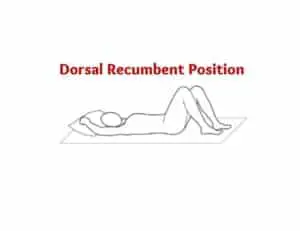What is the dorsal recumbent position?
The dorsal recumbent position is a reclining position in which the patient’s both knees flexed, hips rotated outward, and both soles kept flat on the bed.
It is one of the most commonly used dorsal or supine positions in clinical practice. Also, the dorsal recumbent position is often used synonymously with the supine position. But to be precise, there is a slight difference between both the positions. It is discussed in more detail later in the post.
The nurse uses dorsal recumbent position quietly frequently in their routine work. For example, nurses use dorsal recumbent position for urinary catheterization, physical assessment, and perineal inspection.

Definition
In the clinical setting, the dorsal recumbent position is referred to the position where the patient lays on his/her back, head and shoulders rested on a pillow with the knees flexed, hips rotated outward, and feet flat on the bed.
Pronunciation
Following the pronunciation of the dorsal recumbent position.
daw-sl / ruh-kuhm-bnt / puh-zi-shn
Indication / Uses
The dorsal recumbent position is used for the following purposes.
- To inspect external genitalia
- For vaginal examinations
- For rectal examinations
- For inserting urinary catheter
- For perineal care and catheter care
- During general and specific abdominal assessments
- For offering bedpans
- During whole abdomen and pelvic ultrasonography
- As a comfortable resting position for the patient
Procedure
The steps for positioning the patient in dorsal recumbent position for physical examinations and procedures are as follows.
- Explain the procedure to the patient
- Straighten the bed and help patient to lay on his/her back with knees flexed and both soles resting on the bed.
- Place a single pillow under the head and shoulder
- Ask the patient to relax the thighs.
If the dorsal recumbent position is used for the resting position of a bedridden patient, follow these steps.
- Explain the procedure to the patient
- Straighten the bed and help the patient to lay on his/he back
- Place three to four pillows under the head, neck, and shoulders and one pillow under the knees
- Align the posture correctly and provide foot support
- Document the procedure
Contraindications
Usually, the dorsal recumbent position is a comfortable and safe position for patients. But, when it is used as a resting position for bedridden patients, it could produce shearing force. Which is a risk factor in the formation of decubitus ulcer (bedsore).
Supine Position VS Dorsal Recumbent Position
Often in the literature, supine position and dorsal recumbent position are used interchangeably. Both are dorsal positions. But in practice, there is a slight difference between both positions. The difference between supine position and dorsal recumbent position is tabulated below.
| Supine position | Dorsal Recumbent Position |
| Also called horizontal recumbent position | Often used interchangeably with supine position |
| Patient lies flat on his/her back | Patient lies on his/her back; head and shoulders are slightly elevated with the support of a pillow |
| Legs are straight and feet in a neutral position | Legs are slightly flexed from knees and feet are flat on the bed |
| Bed is straight | Head-end of the bed may be slightly elevated to enhance patient comfort |
Dorsal Recumbent Position VS Semi Recumbent Position
In semi recumbent position, usually, the patient’s head, neck, and shoulders are elevated with three to four pillows or the bed’s head-end is elevated about to 30 to 45 degrees. Which is a variation of fowlers positions.
While the dorsal recumbent position is a comfortable resting position and is also used for physical assessment, vaginal, and rectal examinations.
A study reports that semi recumbent position when the head-end of the bed is elevated to 30 – 45 degrees is effective in preventing ventilator-associated pneumonia (VAP) without many contraindications.
Lithotomy Position VS Dorsal Recumbent Position
Basically, the lithotomy position is a dorsal recumbent position where the patient’s feet are secured in stirrups. Both are variations of dorsal positions.
The dorsal recumbent position is preferred for non-surgical examinations and physical assessment. While lithotomy position is preferred in surgical procedures and childbirth.
Conclusion
In summary, the dorsal recumbent position is a commonly used variation of supine or dorsal positions for resting, examinations, and procedures in the clinical setting.
Medical definition, indications, contraindications, procedure, and how dorsal recumbent position differ from other dorsal positions are discussed above in the article.
Patient Positioning for Nurses
Lithotomy Position |Indication |Variations |Nerve injuries
Sims’ Position |Purpose |variations |procedure
Dorsal Recumbent Position |Definition |Uses |Image
Reverse Trendelenburg Position |Complications |Indication |Benefits
Reference
Boyle, M. (2011). Emergencies Around Childbirth: a handbook for midwives (2nd ed.). Radcliffe Publishing.
Freeman, R., Garite, T., & Nageotte, M. (2003). Fetal Heart Rate Monitoring (3rd ed.). Lippincott Williams and Wilkins.
Funnell, R., Koutoukidis, G., Lawrence, K., & Tabbner, A. (2009). Tabbner’s Nursing Care: Theory and Practice (5th ed.). Churchill Livingstone Elsevier. Kozier, B. (2015). Kozier and Erb’s Fundamentals of Nursing Volumes 1-3 Australian Edition (3rd ed.). Pearson Australia Pty Ltd.




